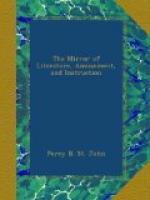When the sulphate of iron and the infusion of galls are added together, for the purpose of forming ink, we may presume that the metallic salt or oxide enters into combination with at least four proximate vegetable principles—gallic acid, tan, mucilage, and extractive matter—all of which appear to enter into the composition of the soluble parts of the gall-nut. It has been generally supposed, that two of these, gallic acid and the tan, are more especially necessary to the constitution of ink; and hence it is considered, by our best systematic writers, to be essentially a tanno-gallate of iron. It has been also supposed that the peroxide of iron alone possesses the property of forming the black compound which constitutes ink, and that the substance of ink is rather mechanically suspended in the fluid than dissolved in it.
Ink, as it is usually prepared, is disposed to undergo certain changes, which considerably impair its value. Of these the three following are the most important: its tendency to moulding, the liability of the black matter to separate from the fluid, the ink then becoming what is termed ropy, and its loss of colour, the black first changing to brown, and, at length, almost entirely disappearing.
Besides these, there are objects of minor importance to be attended to in the formation of ink. Its consistence should be such as to enable it to flow easily from the pen, without, on the one hand, its being so liquid as to blur the paper, or, on the other, so adhesive as to clog the pen, and to be long in drying. The shade of colour is also not to be disregarded: a black, approaching to blue, is more agreeable to the eye than a browner ink; and a degree of lustre, or glossiness, if compatible with the due consistence of the fluid, tends to render the characters more legible and beautiful. With respect to the chemical constitution of ink, I may remark, that although, as usually prepared, it is a combination of the metallic salt or oxide, with all the four vegetable principles mentioned above; yet I am inclined to believe that the last three of them, so far from being essential, are the principal cause of the difficulty which we meet with in the formation of a perfect and durable ink. I endeavoured to prove this point by a series of experiments, of which the following is a brief abstract:—Having prepared a cold infusion of galls, I allowed a portion of it to remain exposed to the atmosphere, in a shallow capsule, until it was covered with a thick stratum of mould; the mould was removed by filtration, and the proper proportion of sulphate of iron being added to the clear fluid, a compound was formed of a deep black colour, which showed no farther tendency to mould, and which remained for a long time without experiencing any alteration.




